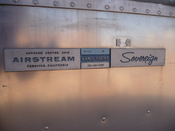
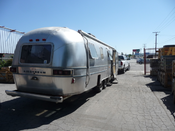
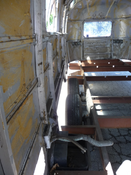

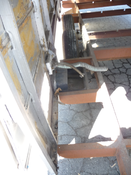
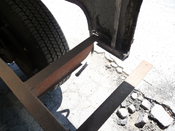

What we got for $500 was the frame and shell of a 1976 31' Airstream International. We already have a trailer that is the same size and year. The important features of the $500 trailer were the awning and the second step which our trailer did not have. Unfortunately it was far from home and the shell was not attached to the frame.
When we got to where the trailer was located, we discovered that the shell was only attached to the frame by 2 bolts at the front of the trailer and that the shell had fallen off the curbside of the frame. We had to fix that. We started by using some straps to put some cross bracing inside of the trailer. Then we got some 4" wide 1/2" strips of wood and some bolts. We jacked up the rear of the shell, put the strips into the C channel and bolted through them to the frame. Then we ran large straps over the top of the trailer and attached them to 2x6s under the trailer. That got the trailer stable enough to move it a few blocks to the Home Depot.
At the home depot, we cut front floor and a rear floor sections, attached those between the frame and the shell, then attached tarps along the frame. We layered the tarps from the front to the back so the air moving underneath would flow under, then we strapped the rearmost tarp below the frame rails to guide the air under the rear floor, but left a gap so any air that did come into the trailer would have an easy way out.
One of the many things that were removed was all of the interior electrical. Fortunately they left the exterior lights, so we got some wire and wired up a few of the lights that we needed for towing at night.
Once all that was done we towed it home between 55-60 MPH and it did great. We only lost the trailer running lights once due to a blown fuse in the truck. When cars would come up behind us we could see the straps inside the trailer and from those we concluded that there was very little air movement inside the trailer. I think the trailer would have been just fine much faster than we pulled it, but we weren't willing to test it.